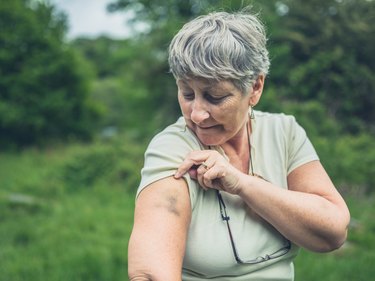
Broken blood vessels may occur under the skin or in the eye. When they are under the skin, they may be called ruptured capillaries or bruises. In the latter case, they are called subconjunctival hemorrhage.
Blood vessels can break in the skin or eye when the pressure around the area is increased, as during a weight-lifting session. You might notice broken blood vessels on your shoulders after working out, such as during a barbell squat when the weight bar presses on the affected area.
Video of the Day
Video of the Day
You could experience a popped blood vessel in your leg from running or develop a bruise after trauma from falls or direct force to the skin.
Identify Red Eyes
Broken blood vessels in the eye are painless and you usually won't even know it's happened until you look in the mirror, or someone says your eye looks like it's "bleeding." Bruises and broken capillaries can be mildly to moderately painful, depending upon their location and severity.
Subconjunctival hemorrhages usually go away on their own within a week or two and need no treatment, according to Mayo Clinic. There are a few steps you can take to speed up the healing of bruises or broken capillaries.
Try Home Remedies
Bruises may be mildly to moderately uncomfortable. To help them heal faster, elevate the area if possible, and apply ice for 10 to 20 minutes at a time, several times per day for the first couple of days after injury, as advised by Mayo Clinic.
Rest the injured area if you can, and take some over-the-counter pain relief as necessary, if approved by your doctor. Be aware that some medications, such as aspirin, can make bruising worse, according to the University of North Carolina Wilmington.
After a few days, or when the bruise appears yellow or green, you may apply heat compresses to help the blood get re-absorbed back into the surrounding tissues. If swelling is also present, elevate the affected limb when sitting to allow gravity to bring extra fluid toward the heart.
An injured arm or leg might also benefit from compression wrapping for a day or two after injury. Avoid wrapping the bandage too tightly — you should be able to slide two fingers between the wrap and your skin.
Seek Medical Attention
Some people bruise more easily than others, and in these cases, bruises can only be prevented by being extra careful not to bang into exercise equipment, drop weights on yourself, or press weights into your shoulders or neck.
Broken blood vessels, when experienced occasionally, are a fact of life for people who exercise, and won't cause long-term damage or injury.
Less commonly, broken blood vessels can indicate a significant injury, such as a torn muscle or broken bone, according to the U.S. National Library of Medicine. Seek immediate medical attention if your bruise causes sharp pain or a deformity in the affected area.
If you experience unexpected bruising, the bruises seem much larger than they should according to the injury sustained, or are accompanied by severe pain or headaches, talk to your doctor immediately to rule out any underlying health problems.
Is this an emergency? If you are experiencing serious medical symptoms, please see the National Library of Medicine’s list of signs you need emergency medical attention or call 911.


